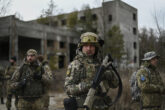September 23, 2021
Presentation is key: Why the Pentagon’s budget data needs a makeover
Within the fiscal 2022 defense budget request, the Department of Defense has invested in the next generation of leading emerging technologies and capabilities. Ironically, at the same time, the way in which the funding of these new capabilities is organized is entirely outdated. As a pleasant surprise, however, the FY22 National Defense Authorization Act, which had its House Armed Services Committee markup hearing earlier this month, requires the DoD to provide reports on how to improve defense budget-related materials.
While improvements to budget data materials don’t earn the award for sexiest line in the NDAA, it was a pleasant surprise to see this issue garner some attention. Although we’ve become accustomed to traversing the treasure trove of budget data, improvements to the materials are long overdue — not only to make the lives of budget analysts easier, but to ensure greater transparency and oversight, thus helping ensure resources align to strategy.
As technology advances, Congress and the DoD need to not only focus investments on capabilities, but also on DoD processes and organizational culture.
Each year, the department releases budget justification documents, which consist of essential budget data, in the form of thousands of PDF pages and several Excel files across multiple websites. The format of these materials has not changed for roughly 20 years.
The first major issue with the presentation of defense budget data is that it’s scattered. Data is dispersed across PDFs and Excel files, making it difficult to accurately and comprehensively cover the financial tracks of an entire program. Moreover, the sorting and tagging functions within the materials are rudimentary at best.
Read the full article from Defense News.
More from CNAS
-
Defense / Transatlantic Security
When Defense Becomes Destruction: Austria-Hungary’s Mistake and Ukraine’s RiskThis article was originally posted on War on the Rocks. The southeastern Polish city of Przemyśl, with its elegant 19th century Habsburg-era train station, remains one of the ...
By Franz-Stefan Gady
-
Defense / Transatlantic Security
Ukraine’s Catch-22 MomentThis article was originally published in the Financial Times. In Joseph Heller’s wartime classic, Catch-22, the protagonist Yossarian seeks out the US army surgeon Doc Daneeka...
By Franz-Stefan Gady
-
CNAS Insights | Budgetary Own Goals Undermine “Speed and Volume”
On November 7, Secretary of Defense Pete Hegseth laid out a plan to overhaul the Department of Defense’s (DOD’s) acquisition system. Placing an emphasis on delivering new capa...
By Philip Sheers, Carlton Haelig & Stacie Pettyjohn
-
Drones: Who Is Making the New Weapons of War?
From Ukraine and Russia to Gaza and Sudan, drones have become a key weapon of war. Which companies are making them, and profiting from this rapidly expanding but controversial...
By Stacie Pettyjohn




